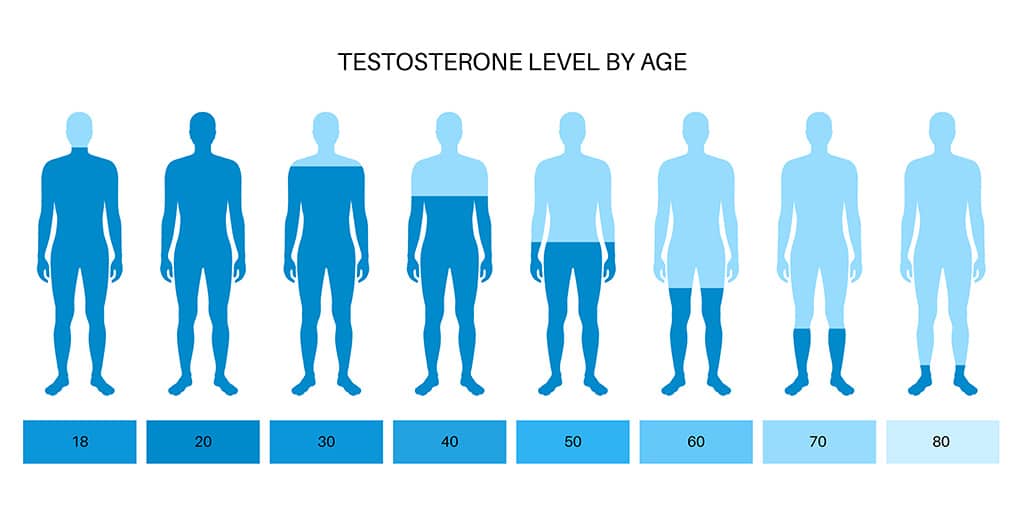
Unlock a More Youthful You With Testosterone Replacement Therapy In Delaware, NJ
Aging is inevitable, and for many, it signals the beginning of a new chapter - one where you cross off bucket list items and live life to the fullest, on your own terms. However, for some men, aging is a horrible prospect, filled with chronic fatigue, irritability, and inability to perform in the bedroom. If you're concerned about life in middle age and beyond, we've got great news: there are easy, proven steps that you can take to help stop the negative effect of aging.
Global Life Rejuvenation was founded to give men a new lease on life - one that includes less body fat, fewer mood swings, and more energy as you age. If you're ready to look and feel younger, it's time to consider TRT (testosterone replacement therapy), and growth hormone peptides. These therapies for men are effective, safe, and customized to fit your goals, so you can keep loving life as you get older.
TRT, and growth hormone peptide therapies bridge the gap between your old life and the more vibrant, happier version of you. With a simple click or call, you can be well on your way to a brighter future. After all, you deserve to be the one in charge of your wellness and health. Now, you have the tools to do so - backed by science and applied by our team of TRT and HRT experts with more than 13 years of experience.

Testosterone Replacement Therapy
- Unlock A More Youthful You With Testosterone Replacement Therapy In Delaware, NJ
- TRT and Anti-Aging Medicine for Men
- Common Symptoms of Low Testosterone
- Benefits of TRT and Anti-Aging Medicine for Men
- Fight Back Against Male Menopause
- Reverse Aging with Growth Hormone Peptides in Delaware, NJ
- Your New, Youthful Lease on Life Starts Here
TRT and Anti-Aging Medicine for Men in Delaware, NJ
For men, getting older comes with its perks, like living life on their own terms and not having to "sweat the small stuff" day in and day out. At the same time, there are aspects of aging that men dread, like hormonal changes. Yes, you read that right – men, not just women, go through hormonal changes as they age. For men, the biggest change involves a drop in testosterone.
Lower levels of testosterone can wreak havoc on a male's mind and body and when left untreated, can result in symptoms like:
- Erectile Dysfunction
- Depression
- Irritability
- Low Sex Drive
- Hair Loss
- Less Muscle Mass
- Problems Concentrating
Those symptoms are concerning, but with testosterone replacement therapy and anti-aging medicine, many males improve their quality of life with age. The good news is that TRT and anti-aging meds aren't only reserved for "old guys." In fact, there's no magic age at which men should start thinking about hormone replacement therapy. Everyone's body is different, so if you're experiencing the above conditions in your mid-30s, TRT could be a viable solution when you consult with a doctor.


What is Testosterone?
Testosterone is a crucial hormone for men and plays an important role throughout the male lifespan. Most of a male's testosterone is produced through the testicles. Also called the male sex hormone, testosterone starts playing its part during puberty.
When a male goes through puberty, testosterone helps males develop:
- Facial Hair
- Body Hair
- Deeper Voice
- Muscle Strength
- Increased Libido
- Muscle Density
As boys turn to men and men grow older, testosterone levels deplete naturally. Sometimes, events like injuries and chronic health conditions like diabetes can lower testosterone levels. Unfortunately, when a man loses too much T, it results in hypogonadism. When this happens, the testosterone must be replaced, or the male will suffer from symptoms like muscle loss, low libido, and even depression.

How Does TRT Work?
TRT is exactly what it sounds like: a treatment option for men that replaces testosterone so that your body regulates hormones properly and restores balance to your life. Also called androgen replacement therapy, TRT alleviates the symptoms that men experience with low T.
Originally lab-synthesized in 1935, testosterone has grown in popularity since it was produced. Today, TRT and other testosterone treatments are among the most popular prescriptions in the U.S.
Without getting too deep into the science, TRT works by giving your body the essential testosterone it needs to function correctly. As the primary androgen for both males and females, testosterone impacts many of the body's natural processes – especially those needed for overall health. For example, men with low T are more prone to serious problems like cardiovascular disease and even type-2 diabetes.
When your body quits making enough testosterone, it causes your health to suffer until a solution is presented. That's where TRT and anti-aging medicine for men can help. TRT helps balance your hormones and replenish your depleted testosterone. With time, your body will begin to heal, and many symptoms like low libido and irritability begin to diminish.

What Causes Low T?
For men, aging is the biggest contributor to lower testosterone levels, though there are other causes like obesity, drug abuse, testicular injuries, and certain prescribed medications. Sometimes, long-term health conditions like AIDS, cirrhosis of the liver, and kidney disease can lower testosterone levels.
When a man's testosterone levels drop significantly, it alters his body's ratio of estrogen and testosterone. Lower testosterone levels cause more abdominal fat, which in turn results in increased aromatase, which converts even more testosterone into estrogen.
If you're concerned that you might have low T, you're not alone. Millions of men in the U.S. feel the same way. The best way to find out if your testosterone is low is to get your levels tested.
For sustainable testosterone replacement therapy benefits, you must consult with hormone doctors and experts like those you can find at Global Life Rejuvenation. That way, you can find the root cause of your hormone problems, and our team can craft a personalized HRT plan tailored to your needs.
Common Symptoms of Low Testosterone
Are you used to blasting through a productive day and accomplishing all your daily goals? Do you find yourself losing muscle mass and the craving to be intimate with your partner? Does your partner complain about how irritable you have become? If you're not usually a curmudgeon, your body could be giving you a sign. It could be time to speak with a doctor about TRT and anti-aging medicine for men in Delaware, NJ.
If you're experiencing any of the following symptoms, you might be battling against low testosterone:

Low Sex Drive
One of the most common reasons that men choose TRT is because they have lost that "spark" with their partner. It's not easy for a man to hear that they're not performing like they used to. Intimacy is a powerful part of any relationship. When a once-healthy sex life dwindles, it can cause serious relationship issues.
The good news is that low libido doesn't have to be a permanent problem. TRT and anti-aging medicines help revert hormone levels back into their normal range. When this happens, many men have a more enjoyable life full of intimacy and sex drive.

Inability to Achieve and Maintain an Erection
Weak erections – it's an uncomfortable subject for many men in the U.S. to talk about. It's even worse to experience first-hand. You're in the midst of an intimate moment, and you can't do your part. Despite being perfectly normal, many men put blame and shame upon themselves when they can't achieve an erection. And while the inability to perform sexually can be caused by poor diet, obesity, and chronic health conditions, low testosterone is often a contributing factor.
Fortunately, weak erections are a treatable condition. The best way to regain your confidence and ability in bed is to speak with your doctor. Once any underlying conditions are discovered, options like TRT may be the best course of treatment.
Hair Loss

Loss of Strength and Muscle Mass
Do you find it harder and harder to work out and lift weights in the gym? Are you having problems lifting heavy items that you once had no problem lifting?
Recent studies show that when men are inactive, they lose .5% of muscle strength every year, from ages 25 to 60. After 60, muscle loss doubles every decade. While some muscle loss is common as men age, a significant portion can be tied to low testosterone levels. When a man's T levels drop, so does his muscle mass.
Testosterone is a much-needed component used in gaining and retaining muscle mass. That's why many doctors prescribe TRT Delaware, NJ, for men having problems with strength. One recent study found that men who increased their testosterone levels using TRT gained as much as 2.5 pounds of muscle mass.
Whether your gym performance is lacking, or you can't lift heavy items like you used to, don't blame it all on age. You could be suffering from hypogonadism.

Hair Loss
If you're like millions of other men in their late 20s and 30s, dealing with hair loss is a reality you don't want to face. Closely related to testosterone decline and hormone imbalances, hair loss is distressing for many men. This common symptom is often related to a derivative of testosterone called DHT. Excess amounts of DHT cause hair follicles to halt their production, causing follicles to die.
Because hair located at the front and crown is more sensitive to DHT, it grows slower than other follicles and eventually stops growing permanently. Thankfully, TRT and anti-aging treatments for men in Delaware, NJ, is now available to address hair loss for good.
While it's true that you can't change your genes, you can change the effects of low testosterone on your body. Whether you're suffering from thinning hair or hair loss across your entire head, TRT and other hormone therapies can stop hair loss and even reverse the process.

Gynecomastia
Also called "man boobs," gynecomastia is essentially the enlargement of male breast tissue. This increase in fatty tissue is often caused by hormonal imbalances and an increase in estrogen. For men, estrogen levels are elevated during andropause. Also called male menopause, andropause usually happens because of a lack of testosterone.
If you're a man between the ages of 40 and 55, and you're embarrassed by having large breasts, don't lose hope. TRT is a safe, effective way to eliminate the underlying cause of gynecomastia without invasive surgery. With a custom HRT and fitness program, you can bring your testosterone and estrogen levels back to normal before you know it.

Decreased Energy
Decreased energy was once considered a normal part of aging. Today, many doctors know better. Advances in technology and our understanding of testosterone show that low T and lack of energy often go hand-in-hand.
If you're struggling to enjoy activities like playing with your kids or hiking in a park due to lack of energy, it could be a sign of low T. Of course, getting tired is perfectly normal for any man. But if you're suffering from continual fatigue, a lack of enjoyment, or a decrease in energy, it might be time to speak with a doctor.
Whether you're having a tough time getting through your day or can't finish activities you used to love, TRT could help.

Lack of Sleep
A study from 2011 showed that men who lose a week's worth of sleep can experience lowered testosterone levels – as much as 15%, according to experts. Additional research into the topic found almost 15% of workers only get five hours of sleep (or less) per night. These findings suggest that sleep loss negatively impacts T levels and wellbeing.
The bottom line is that men who have trouble sleeping often suffer from lower testosterone levels as a result. If you find yourself exhausted at the end of the day but toss and turn all night long, you might have low T.
TRT and anti-aging medicines can restore your T levels back to normal, which can help you sleep better with proper diet and exercise.

Depression
You're feeling down about everything, and there's no solid explanation for why you're in such a crummy mood. Your daily life is great and full of success, but you can't help but feel unexcited and unmotivated. If you're experiencing symptoms like these, you may be depressed – and it may stem from low testosterone.
A research study from Munich found that men with depression also commonly had low testosterone levels. This same study also found that depressed men had cortisol levels that were 67% higher than other men. Because higher cortisol levels lead to lower levels of testosterone, the chances of severe depression increase.
Depression is a very real disorder and should always be diagnosed and treated by your doctor. One treatment option gaining in popularity is TRT for depression. Studies show that when TRT is used to restore hormone levels, men enjoy a lighter, more improved mood. That's great news for men who are depressed and have not had success with other treatments like anti-depression medicines, which alter the brain's chemistry.

Inability to Concentrate
Ask anyone over the age of 50 how their memory is, and they'll tell you it wasn't what it used to be. Memory loss and lack of concentration occur naturally as we age – these aren't always signs of dementia or Alzheimer's.
However, what many men consider a symptom of age may be caused by low testosterone. A 2006 study found that males with low T levels performed poorly on cognitive skill tests. These results suggest that low testosterone may play a part in reducing cognitive ability. If you're having trouble staying on task or remembering what your schedule is for the day, it might not be due to your age. It might be because your testosterone levels are too low. If you're having trouble concentrating or remembering daily tasks, it could be time to talk to your doctor.
Why? The aforementioned study found that participating men experienced improved cognitive skills when using TRT.

Weight Gain
Even though today's society is more inclusive of large people, few adults enjoy gaining weight as they age. Despite their best efforts, many men just can't shed the extra pounds around their midsections, increasing their risk of heart disease and cancer.
Often, male weight gain is caused by hormone imbalances that slow the metabolism and cause weight to pile on. This phase of life is called andropause and happens when there is a lack of testosterone in the body. Couple that with high cortisol levels, and you've got a recipe for flabby guts and double chins.
Fortunately, TRT treatments and physician-led weight loss programs can correct hormone imbalances and lead to healthy weight loss for men.
Benefits of TRT and Anti-Aging Medicine for Men in Delaware, NJ
The benefits of hormone replacement therapy for men are numerous. TRT not only grants relief from low-T symptoms but can help give protection against age-related diseases. Additionally, doctors now recognize male testosterone as an important role in alleviating depression.
Some of the most exciting benefits of TRT can include:
- Reduction in Body Fat
- Increased Strength
- More Muscle Mass
- More Energy
- Lower Risk of Erectile Dysfunction
- Higher Sperm Production
- Healthy Reproductive Tissues
- Lower Risk of Heart Disease and Diabetes
- Lower Risk of Anxiety
- Lower Risk of Depression


Fight Back Against Male Menopause
Because men do not go through a specific period of hormonal changes like women do (called menopause), many doctors refer to "male menopause" as androgen decline. This is just another term for low testosterone, but like female menopause, the symptoms can be serious and affect your quality of life.
The best way to fight back against male menopause is with male HRT treatment from Global Life Rejuvenation. We provide the following HRT treatments for men:
- Testosterone Replacement Therapy (TRT)
- Sermorelin (Sermorelin Acetate)
- Human Growth Hormone (HGH)
Our treatment options are personalized for your body and are available as creams, gels, injectables, and implantable pellets. To find out if testosterone replacement therapy is safe for you, contact Global Life Rejuvenation today to schedule your comprehensive testing and anti-aging treatment consultation.
Reverse Aging with Growth Hormone Peptides in Delaware, NJ
Growth hormone peptides are an innovative therapy that boosts the natural human growth hormone production in a person's body. These exciting treatment options help slow down the aging process and give you a chance at restoring your youth.

What is Sermorelin?
Sermorelin is a synthetic hormone peptide, like GHRH, which triggers the release of growth hormones. When used under the care of a qualified physician, Sermorelin can help you lose weight, increase your energy levels, and help you feel much younger.

Benefits of Sermorelin
Human growth hormone (HGH) therapy has been used for years to treat hormone deficiencies. Unlike HGH, which directly replaces declining human growth hormone levels, Sermorelin addresses the underlying cause of decreased HGH, stimulating the pituitary gland naturally. This approach keeps the mechanisms of growth hormone production active.
Benefits of Sermorelin include:
- Better Immune Function
- Improved Physical Performance
- More Growth Hormone Production
- Less Body Fat
- Build More Lean Muscle
- Better Sleep

What is Ipamorelin?
Ipamorelin helps to release growth hormones in a person's body by mimicking a peptide called ghrelin. Ghrelin is one of three hormones which work together to regulate the growth hormone levels released by the pituitary gland. Because Ipamorelin stimulates the body to produce growth hormone, your body won't stop its natural growth hormone production, which occurs with synthetic HGH.
Ipamorelin causes growth hormone secretion that resembles natural release patterns rather than being constantly elevated from HGH. Because ipamorelin stimulates the natural production of growth hormone, our patients can use this treatment long-term with fewer health risks.

Benefits of Ipamorelin
One of the biggest benefits of Ipamorelin is that it is suitable for both men and women. It provides significant short and long-term benefits in age management therapies, boosting patients' overall health, wellbeing, and outlook on life. When growth hormone is produced by the pituitary gland using Ipamorelin, clients report amazing benefits.
Some of those benefits include:
- Powerful Anti-Aging Properties
- More Muscle Mass
- Less Unsightly Body Fat
- Deep, Restful Sleep
- Increased Athletic Performance
- More Energy
- Less Recovery Time for Training Sessions and Injuries
- Enhanced Overall Wellness and Health
- No Significant Increase in Cortisol
Your New, Youthful Lease on Life Starts Here
Whether you are considering our TRT services, HRT for women, or our growth hormone peptide services, we are here to help. The first step to turning back the hand of time starts by contacting Global Life Rejuvenation.
Our friendly, knowledgeable TRT and HRT experts can help answer your questions and walk you through our procedures. From there, we'll figure out which treatments are right for you. Before you know it, you'll be well on your way to looking and feeling better than you have in years!
 866-793-9933
866-793-9933
Request a Consultation
Latest News in Delaware, NJ
Delaware Tribe members teach Paterson students about their Lenape heritage
Joe Malinconicohttps://www.northjersey.com/story/news/paterson-press/2023/11/24/paterson-nj-delaware-tribe-members-share-lenape-heritage/71679832007/
PATERSON — For Jeremy Johnson, a recent trip to three city elementary schools was an opportunity to share his Lenape heritage in a place he calls his “homelands.”Johnson and the other four members of a delegation from the Delaware Tribe of Indians performed a traditional tribal dance, told a folktale that predated European colonization of the area now known as New Jersey, and presented students with a slide show detailing the cultural symbols and history of the Lenape people.“It's importan...
PATERSON — For Jeremy Johnson, a recent trip to three city elementary schools was an opportunity to share his Lenape heritage in a place he calls his “homelands.”
Johnson and the other four members of a delegation from the Delaware Tribe of Indians performed a traditional tribal dance, told a folktale that predated European colonization of the area now known as New Jersey, and presented students with a slide show detailing the cultural symbols and history of the Lenape people.
“It's important to share this so that we are remembered in our homelands, and it’s also a way to get our community members out to share what they know about our people,” said Johnson, cultural education director for the Delaware Tribe of Indians.
“It’s something that needs to be carried on because we have been largely forgotten in our homelands,” Johnson added. “This program is a means for our people to remain attached to our homelands so that we still have a place here to come back to.”
National Park Service partnered with Delaware Tribe, Paterson schools
The National Park Service partnered with the Delaware Tribe and the Paterson school district to make the program happen. Johnson and his group visited fourth graders at School 1, School 2 and School 28 last week.
“The National Park Service is constantly improving the ways we tell the stories of this country,” said Ilyse Goldman, a ranger at Great Falls National Historical Park. “The Indigenous people of this land have not played as prominent a role, but we’re trying to correct that wrong now as an agency. Having a relationship with all of the federally recognized tribes of the Lenape is correcting the myths; it’s remembering that native people were and are here.”
Schools Superintendent Laurie Newell, who attended the School 28 session, talked about the value of the program.
“There are parts of American history that our children must become more familiar with in order to fully appreciate the rich traditions to be found here,” Newell said. "The Lenape people’s words are all over New Jersey as names of towns, cities and streets whose origins have been lost to the general public, and this outreach is a great step in redressing that.”
'Little Palestine':In Paterson, a community is united in grief
In the schools:Is a student recruitment program boosting enrollment in Paterson schools?
Delaware Tribe members traveled from Oklahoma
The Delaware Tribe members traveled to Paterson from their homes in Oklahoma. After many centuries of living on North America’s Eastern Seaboard, the Lenape were sent to Oklahoma in the 19th century as part of the American government’s forced migration of Native Americans.
Among those who made the trip was Johnson’s mother, Laura Maynor.
“It’s very important to us to share what was done in the past and for people to know that the Lenape are still here; we are around,” Maynor said. “I love that my son has a passion for this. He knows a lot, which was learned from his great-grandmother, grandmother, and then me. I’m very proud of him.”
Minimum wage increases in New Jersey and Delaware for 2024. Here's how much:
FOX 29 News Philadelphiahttps://www.fox29.com/news/minimum-wage-increasing-in-new-jersey-and-delaware-in-2024-heres-how-much
The New Year is starting off with some good news for workers in New Jersey and Delaware - a larger paycheck!The minimum wage increased in both states on January 1, 2024.New Jersey increased the state minimum wage to $15.13 per hour for most employees."I think it’s amazing to be honest with you because the price of living nowadays is so difficult for anybody, whether they be single, married, or just in a partnership with somebody. To even live without kids it’s hard nowadays, for it to go up, it’s g...
The New Year is starting off with some good news for workers in New Jersey and Delaware - a larger paycheck!
The minimum wage increased in both states on January 1, 2024.
New Jersey increased the state minimum wage to $15.13 per hour for most employees.
"I think it’s amazing to be honest with you because the price of living nowadays is so difficult for anybody, whether they be single, married, or just in a partnership with somebody. To even live without kids it’s hard nowadays, for it to go up, it’s great for people, hopefully it will help," said Ashley Mcaleer of New Jersey.
The raise is $7.88 more than the federal minimum wage in the United States, which has remained at $7.25 an hour since 2009.
The increase is part of a bill signed by Gov. Phil Murphy in 2019.
Some workers will see slower increases, both seasonal employees and businesses with fewer than six workers will see their increase go up a dollar from $12.73 to $13.73, with a goal of reaching $15 in 2026.
Agricultural workers are guided by a separate minimum wage timetable and were given until 2027 to reach the $15/hour minimum wage. Employees who work on a farm for an hourly or piece-rate wage will see their minimum hourly wage increase by 80 cents to $12.81/hour, up from $12.01/hour. Additionally, long-term care facility direct care staff will see their minimum wage rise by $1, to $18.13/hour.
Tipped workers’ cash wage will remain at $5.26/hour, with employers able to claim a $9.87 tip credit, an increase of $1. If the minimum cash wage plus an employee’s tips do not equal at least the state minimum wage, the employer must pay the employee the difference.
Murphy said, "Over 350,000 hourly workers will benefit from this much needed boost in earnings— a long and hard fought victory for working families across our state".
"I think that’s wonderful. I think everyone should be able to live in the United States and make enough money to support themselves and their family, it being anything less than fifteen, it’s impossible to do that," said Lauren Hines of New Jersey.
Delaware has also increased their minimum wage from $11.75 to $13.25, with the goal of reaching $15 in 2025.
This increase will be $6 higher than the federal minimum wage.
Both increases are part of in New Jersey, Delaware and Pennsylvania in 2024.
22 states have increased their minimum wage, with New Jersey including Delaware.
Across the river in PA, the minimum wage remains at the federal minimum wage of $7.25, a number that hasn’t changed since 2009.
A dollar amount that was a shock to those in New Jersey.
"Excuse me, $7.25, over there, no, no, ain’t no way, it ain’t worth it, I wouldn’t do it," said Peters.
"That’s insane and I think that hopefully changes. I would love to see a Federal push that would force all states to be at least $15 so, hopefully, we get that in the future," said Hines.
Which those in Pennsylvania are hoping for the same thing.
"It’s very unfortunate, I feel like it should go up and should follow what needs to be done to keep everybody afloat nowadays, especially with everybody that is struggling," says Steven Carver of Pennsylvania.
Invasive blue catfish threaten marine ecosystems in Delaware River Watershed
Andrew S. Lewishttps://www.njspotlightnews.org/2024/01/northern-snakehead-freshwater-drum-invasive-species-mid-atlantic-panel-on-aquatic-invasive-species-pennsylvania-department-of-environmental-protection-edna-alloways-creek-atlantic-sturgeon-russell-pet/
“This is ground zero,” Mike Steiger, a fisheries biologist with Delaware’s Department of Natural Resources and Environmental Control, said one morning last month. Steiger was standing on a wooden walkway in the Russell Peterson Wildlife Refuge, looking over the steel-gray Christina River, a narrow tributary that twists through Wilmington, Delaware and along I-95, eventually spilling into the Delaware River. “This is the first place we found them.”That first find was a decade ago. In 2013, a recreational f...
“This is ground zero,” Mike Steiger, a fisheries biologist with Delaware’s Department of Natural Resources and Environmental Control, said one morning last month. Steiger was standing on a wooden walkway in the Russell Peterson Wildlife Refuge, looking over the steel-gray Christina River, a narrow tributary that twists through Wilmington, Delaware and along I-95, eventually spilling into the Delaware River. “This is the first place we found them.”
That first find was a decade ago. In 2013, a recreational fisherman hooked an unfamiliar, 25-inch brute of a fish while casting into the Christina from a boat ramp in the town of Newport, about two miles from where Steiger now stood. The fisherman knew he had a catfish, but it didn’t look like a channel catfish, a common species in the Delaware River Watershed. He snapped a photo and sent it off to the natural resources department.
The department forwarded the image to fishery biologists at the Virginia Institute of Marine Science who were quickly able to confirm that the fish in question was a blue catfish. The Christina “blue cat” was the first of its kind recorded in the watershed, but it would not be the last. These days, Steiger and his counterparts in Pennsylvania and New Jersey are bracing for an invasion that has already upended marine ecosystems in Virginia and Maryland.
At first, the Christina blue catfish appeared to be an anomaly. The Delaware natural resources staff had put out an alert to Delaware anglers, asking them to notify the department of any other blue catfish encounters, but no additional reports surfaced for another five years. “For a long time, we wondered if someone had stocked this one fish here and that the fisherman just happened to catch it,” Steiger said.
How the blue catfish got in
But then, in 2018, during their annual gill-net surveys in the Delaware River, not far from the mouth of the Christina and adjacent to South Jersey’s Pennsville Township, Steiger and his colleagues hauled up more blue catfish. The following year, Steiger finally got what he believes is the answer to the question of how the lone 2013 fish had made it into the Christina: that September, eight big blue catfish were caught in the C&D Canal, the manmade corridor connecting the Delaware Bay with the Chesapeake Bay.
Blue catfish ‘are big, angry, slimy, eating machines.’ — Mike Steiger, Department of Natural Resources and Environmental Control, Delaware
The reports have poured in ever since. “I believe the northeast section of the Chesapeake Bay,” Steiger said, “is feeding our infestation.”
Chris Smith, who oversees invasive aquatic species for the New Jersey Department of Environmental Protection, agrees. “We don’t know for sure if the C&D Canal is directly where they came from,” Smith said. “But we can speculate that it’s the most likely pathway the blue cat took.”
Effect on ecosystem
“Invasive” is a tricky label. The channel catfish, which most New Jersey anglers would consider native, was in fact introduced in the state’s waters about a century ago. The largemouth bass, a beloved game species among freshwater fishermen, comes from the Mississippi River basin and the Southeast. At this point in history, when humans have so thoroughly and haphazardly scattered plants and animals across the globe, it is less about a species’ origin than it is about the impact it may have on its new ecosystem.
And blue catfish, Steiger said, “are big, angry, slimy, eating machines.”
In the 1970s, blue catfish — named for their silvery-blue hue — were stocked in Virginia to boost recreational fishing in the Rappahannock, York and James rivers, whose ecosystems had been decimated by decades of pollution. Unlike the rivers’ native species, especially the shad and Atlantic sturgeon, blue catfish and other nonnative species, like the northern snakehead, thrive in the kind of low-oxygen environments that result from poor water quality.
Feasting on native species
Though they are native to the Mississippi, Missouri, Ohio, and Rio Grande river basins, blue catfish have also proven to be tolerant of salty water. When they reached the mouths of the Rappahannock, York and James, they had the entire Chesapeake Bay before them. Year by year, they crept north, vacuuming up native species, like menhaden, shad, river herring and blue crab.
Steiger and Smith worry that mature blue catfish may also enjoy eating young Atlantic sturgeon, a particularly worrying preference in the Delaware River and Bay, where fewer than 250 spawning adults remain. Each fall, Steiger and his colleagues conduct net sampling of juvenile Atlantic sturgeon in the Delaware River, about three miles downriver of the Christina’s mouth, and in recent years they’ve found blue catfish in their nets. “We’re only catching little ones, but if a 100-pounder was there, it could definitely eat a juvenile Atlantic sturgeon,” Steiger said. “We haven’t seen it yet, but it absolutely could happen.”
Blue catfish are equally voracious when it comes to reproduction — an aquatic version of the rabbit. During the spawning season, which runs from late May to June, a female blue catfish will produce up to 8,000 eggs per kilogram (2.2 pounds) of her body weight. The species can grow up to 5 feet and weigh over 100 pounds — a size that could yield over 360,000 eggs. (The world record, caught in Kerr Lake, Virginia, weighed 143 pounds.) “Snakeheads actually eat each other, so their numbers are kept down that way,” Steiger said. “Blue cats protect their young, so their numbers tend to explode.”
The Mid-Atlantic Panel on Aquatic Invasive Species brings together state and federal agencies, academic institutions, environmental groups and other stakeholders to develop and coordinate strategies to manage an ever-growing list of destructive invasive species.
In New Jersey, says Smith, word-of-mouth reports of anglers catching blue catfish have made their way to the DEP for the past decade. But it wasn’t until 2021 that the department received a photo of a blue catfish that was caught in Salem County’s Lower Alloways Creek, a Delaware River tributary that is south of the C&D Canal and close to where the river turns into the Delaware Bay.
That the species is heading toward saltier water is a concern for the DEP, Smith said. He used the northern snakehead as a cautionary example. “We’ve confirmed them as far south as the Cohansey River this year, and, most likely, they will continue to expand down to the Maurice River.” Both the Cohansey and Maurice rivers are in Cumberland County.
Anglers not dependable source of data
As of now, though, Smith and his colleagues have not detected any blue catfish below Lower Alloways Creek. But relying on anglers to map the species’ movement through the watershed is problematic. Many don’t bother — or don’t know — to report their catch to the DEP.
To fill that gap, Smith is hoping that, in the coming years, the DEP will invest in eDNA sampling, which is the process of identifying plant and animal species by analyzing the DNA they leave behind in the water column. “It’s a great screening tool,” Smith said. “We won’t have to do electrofishing” — a tool that uses an electrical current to temporarily stun fish — “or put a net in the water. We can just take a water sample and get a better indication of the distribution of species.”
Both Smith and Steiger, along with their counterpart in Pennsylvania’s Department of Environmental Protection, Sean Hartzell, are part of the Mid-Atlantic Panel on Aquatic Invasive Species, which brings together state and federal agencies, academic institutions, environmental groups and other stakeholders to develop and coordinate strategies to manage an ever-growing list of destructive invasive species. But, Steiger said, “we all get together and update each other twice a year.”
For now, though, the most effective way to stay ahead of the blue catfish’s spread throughout the Delaware River Watershed is regular coordination between Smith, Steiger, and Hartzell. If an angler reports a blue catfish or a northern snakehead or a freshwater drum — another recent arrival to the watershed — the three biologists will add that information to their growing body of research. If one turns up in the Delaware team’s Atlantic sturgeon nets, Steiger will alert the others.
Most importantly, Smith and Steiger said, is that anglers know a blue catfish when they see one, so that they can report it back to their state environmental agency. And then, if they’d like, they can take their catch home for dinner.
New laws now in effect in Pennsylvania, New Jersey and Delaware as 2024 begins
FOX 29 Staffhttps://www.fox29.com/news/new-laws-taking-effect-in-pennsylvania-new-jersey-and-delaware-in-2024
PHILADELPHIA - New year, new me is often the motto as the clock strikes midnight on New Year's Eve. However, January 1 also marks the day several laws that could impact your everyday life go into effect.Here's a look at the new bills signed into law for Pennsylvania, New Jersey and Delaware for 2024:Preferred Organic Program TrademarkThe bill will further h...
PHILADELPHIA - New year, new me is often the motto as the clock strikes midnight on New Year's Eve. However, January 1 also marks the day several laws that could impact your everyday life go into effect.
Here's a look at the new bills signed into law for Pennsylvania, New Jersey and Delaware for 2024:
Preferred Organic Program Trademark
The bill will further help farmers further identify which products come from then in local grocery stores.
"Products that earn the PA Preferred Organic brand will give consumers confidence they are getting a quality product that meets the high standards they expect."
Flood Insurance Premium Assistance Task Force
The bill will help homeowners acquire flood insurance, which is now required by the state.
"The task force would issue recommendations regarding potential programs that provide premium discounts, programs that incentivize local governments to support flood mitigation efforts and the implementation of any necessary changes to state statute or policy regarding the administration of flood insurance."
The bill will "extend and revamp the school bus stop arm automated enforcement program."
Military Personnel - Residency Status for Students
This bill grants limited residency to those stationed at a military outpost in Pennsylvania.
This bill makes changes to the state dog law, including how licenses are issued, rules for kennels, and reinforces penalties against violators.
Some other laws now in effect in Pennsylvania include felonies for porch pirates, probation reform, and voter registration at the DMV.
This bill increases New Jersey’s statewide minimum wage by $1 to $15.13 per hour for most employees.
This bill will make birth control available over the counter at participating pharmacies.
New gun trafficking legislation also allows for new first and second degree penalties, as well as the ability to charge out of state traffickers.
This bill increases the minimum wage in Delaware to $13.25 an hour.
Businesses subject to the Hazardous Substance Cleanup Act (HSCA) will see a decrease in last year’s rate from 0.8389% to 0.675%.
State unemployment insurance (SUI) tax relief
"This Act will continue for calendar year 2024 the temporary relief provided in calendar year 2023 to employers who pay unemployment tax assessments."
Recreational marijuana is also now legal to use and purchase in the state of Delaware.
Minimum wages are going up in 2024 for workers in NJ, Del., but not in Pa.
Emily Rose Grassihttps://www.nbcphiladelphia.com/news/business/minimum-wage-increases-2024-new-jersey-delware-pennsylvania/3725711/
The start of 2024 is right around the corner. With a new year comes fireworks, resolutions and (for some) wage increases.Well, some workers in New Jersey and Delaware will be seeing a boost in their paychecks starting on Jan. 1, 2024, but workers in Pennsylvania won't.Here's a breakdown of each state's minimum wage rates for the new year:New Jersey workers get an extra buckLow-wage workers in ...
The start of 2024 is right around the corner. With a new year comes fireworks, resolutions and (for some) wage increases.
Well, some workers in New Jersey and Delaware will be seeing a boost in their paychecks starting on Jan. 1, 2024, but workers in Pennsylvania won't.
Here's a breakdown of each state's minimum wage rates for the new year:
New Jersey workers get an extra buck
Low-wage workers in New Jersey will see their minimum wage rate jump a dollar per hour, from $14.13 to $15.13.
If you're working as a seasonal employee or for a business with as few as six employees, the minimum wage is expected to follow suit, jumping a buck from $12.93 to $13.93 per hour.
Agricultural employees will see a slightly lower 80 cent increase as the minimum wage goes from $12.01 to $12.81 per hour.
For employees who also receive tips, their wages will remain the same at $5.26 per hour. For details on the rights and protections of tipped workers, click here.
Workers in New Jersey who don't see the increase reflected in their paychecks can file a complaint here.
Delaware workers can expect $2 more per hour
The wage increase in the First State is more straight forward.
Workers in Delaware have seen their minimum wage steadily increase each year since 2020 as the state nears its goal of $15 per hour by 2025.
On Jan. 1, 2024, the minimum wage will jump from $11.75 to $13.75 per hour.
The minimum wage does not include workers in agriculture jobs, domestic services, federal government roles, commission sales, fish industry employees and inmates in department of correction programs.
Pennsylvania workers stand pat
Sorry to say, but the state of Pennsylvania is not planning to raise its minimum wage rate as the calendar turns to 2024. The wage currently stands at $7.25 per hour.
But, there is some good news. Over the summer, the state's House of Representatives passed a bill that would raise the minimum wage to $15 per hour by 2026. The bill was then sent to the Pennsylvania Senate.
Disclaimer:


